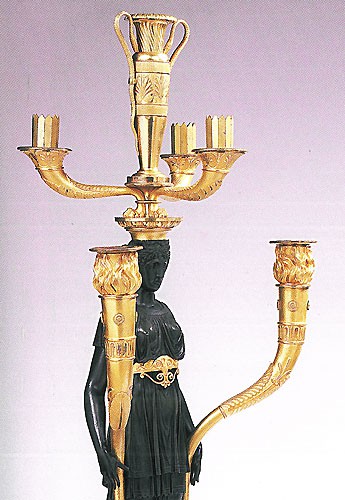After his appointment as King of Naples on 15 July, 1808, Prince Murat, grand duc de Berg, handed over to the French emperor (by means of a “convention particulière”, a private agreement) everything he owned in France. These belongings included, notably, the Elysée Palace, which Murat had bought in 1805 in a bid to live up to the highly dignified title of prince that he had just recently been granted. The French architects Vignon and Thibault redesigned and refurbished the Marquise de Pompadour's former residence to such a level of splendour that it soon became known as one of the standout examples of the French capital's palatial properties. Thus, a selection of the splendid furnishings that graced the Murat family's palace passed, in 1808, into the imperial collections of the Garde-Meuble, today known as the Mobilier national.
According to the inventories drawn up for 1808 and 1809, this pair of candelabra could be found in the bedchamber of the Princess Murat's private apartments, located on the ground floor of the Elysée Palace. This room went on to become the emperor's own bedchamber. And in the inventory from 1813, the candelabra crop up on the first floor of the building, in the empress' private study; by 1817, they had moved again, this time into the principal salon of the large suite of apartments on the ground floor. And during the Second Empire, they returned to the bedchamber, this time occupied by the emperor. The candelabra were finally removed from the Elysée Palace in 1872.
After the destruction and devastation of the Revolution, there was a huge demand for refurbishments and decorations which, during the Consulate and First Empire, saw an explosion in the production of furnishings and objets d'art. Bronze was particularly popular; no longer restricted to furniture, it began to feature more and more in decorative arts, from light fixtures and dinner services to, in particular, the rapidly expanding clock production industry. The unmatched quality in the bronze work of this period is due in no small part to the expertise of an essentially Parisian industry. No fewer than sixty highly specialised craftsmen receive a mention in an edition of the Almanach du Commerce (a Paris-based trade register), published at the fall of the Empire. In the above examples, a patinated bronze caryatid figure bearing six candle holders is mounted on a square plinth made from sea green marble and bronze. Three branches extend from the head, which also bears an oval, snake-handled amphora, whilst in her hands the woman is carrying two horns. Antiquity also dominates the plinth's design: the front face depicts two female figures dancing to the sound of their musical instruments, whilst, on the side faces, two lovers are represented bearing torches.
Karine Huguenaud (tr. H.D.W.)
Source: Marie-France Dupuy-Baylet, L'heure, le feu, la lumière 1800-1870. bronzes du Garde-Meuble impérial et royal, Faton 2010.
January 2011
Pair of candelabra

- Date :
- Around 1805
- Technique :
- Gilded bronze, patinated bronze, green marble
- Dimensions :
- H = 84.5 cm, L = 28 cm, P = 20.5 cm
- Place held :
- Mobilier national
- Photo credit :
- © Mobilier national - Isabelle Bideau

